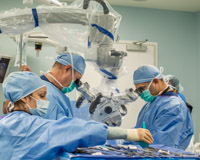A herniated disc is a painful, often debilitating condition where a fragment of the soft nucleus of an intervertebral disc pushes through the tough outer annulus. In other words, the tissue between vertebrae ends up where it shouldn't be. In many cases, herniated discs pinch the nerve roots near the vertebrae, resulting in burning, tingling and/or numbness. While herniated discs can greatly impair a patient's quality of life, there are many treatment paths that can get patients back to being pain-free.
Herniated Discs 101
Every year, around 3 million patients seek care for herniated discs in the United States. And though the condition is common, its effects can often manifest as extreme, debilitating pain. Often, disc herniations occur in the lower region of the back known as the lumbar spine. This rupture of a vertebral disc can be caused by the normal wear of aging or by traumatic injury. A herniated disc can push against a nerve root, sending pain down the sciatic nerve and resulting in a burning, tingling and/or numbing sensation from the lower back down to one or both feet.
Fortunately, many surgical and nonsurgical treatments are effective at eliminating symptoms associated with a herniated disc. The physicians at DISC offer a wide range of soft tissue, pain management and microsurgical options for the treatment of disc herniation.
What causes disc herniations?
Intervertebral disc herniations are common, as the annulus dehydrates and loses strength naturally as one ages. Certain lifestyle choices, such as frequent sitting, occupations that require repetitive motions, improper weight lifting, and smoking may all increase the likelihood to suffer from a herniated disc.
What should I do?
If experiencing problematic lower back pain that radiates down the leg, or consistent pain in the arm, consult your physician. A physical examination, neurological examination, and imaging techniques will reveal definitively if symptoms are the result of a herniated disc. To schedule an appointment with a board certified physician click here.
Fortunately there are many surgical and non-surgical therapies to alleviate symptoms caused by a herniated disc.
The majority of patients find relief through non-surgical therapies. Three to four months of physical therapy is typically recommended. Intense pain and muscle spasm should be addressed with adequate bed rest while maintaining a light walking regiment. Anti-inflammatory medications are often prescribed to help with pain and local inflammation of damaged tissues. In certain cases pain management may include corticosteroid injections to allow physical therapy to continue.'
Testimonial: Herniated Disc Patient
Schedule an appointment with one of DISC's spine experts who can help you overcome a herniated disc via minimally invasive means.

About the author
discmdgroup DISC Sports & Spine Center (DISC) is a national leader in minimally invasive spine surgery, orthopedic surgery, and sports medicine care. Our spine surgeons set the standard in artificial disc replacement, spine fusion, discectomy, microdiscectomy and the full spectrum of spine procedures. The group’s orthopedic surgeons advance the state of joint preservation surgery and total joint replacement, including total knee replacement as well as total hip replacement. Our flagship surgery centers based in Newport Beach, Marina del Rey, and Carlsbad serve patients local to Los Angeles, Orange County and San Diego, as well as the rest of the country. Read more articles by discmdgroup.




